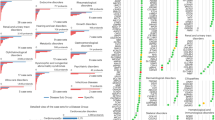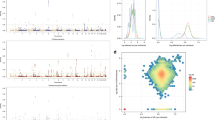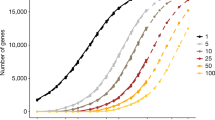Abstract
We screened DNAs from 48 Japanese individuals for single-nucleotide polymorphisms (SNPs) in eight genes encoding G protein-coupled receptors (GPCRs) by directly sequencing the entire relevant genomic regions except for repetitive-sequence elements. This approach identified 147 SNPs and 31 insertion/deletion polymorphisms among the eight GPCR genes. On average, we identified one SNP in every 584 nucleotides. Of the 147 SNPs, 69 were identified in AGTR1, 12 in AGTR2, nine in AGTRL1, 20 in AVPR1A, nine in AVPR2, 16 in DRD1, six in ITGA2B, and six in PTGIR. Twenty-one SNPs were located in 5' flanking regions, 76 in introns, 32 in exons, and 18 in 3' flanking regions. These variants should contribute to investigations of possible correlations between genotypes and phenotypes as regards susceptibility to disease or responsiveness to drug therapy.
Similar content being viewed by others
Introduction
Polymorphic sites within genes encoding G protein-coupled receptor (GPCRs) may yield possible correlations between genotypes and disease-susceptibility phenotypes or responsiveness to drug therapy (Rana et al. 2001). A number of investigators have already reported numerous polymorphisms in all domains of many GPCR genes (Rana et al. 2001; Small et al. 2003). Eight GPCR genes selected for the work reported here are described in the following paragraphs:
-
Angiotensin II receptors types 1 and 2 (AGTR1 and AGTR2 respectively), mediated by the renin-angiotensin system, play important roles in cardiovascular pathophysiology (Wagenaar et al. 2002) and are considered the most important receptors in that context (Whitebread et al. 1989). Stimulation of AGTR1 leads to physiological effects such as vasoconstriction, inflammation, and proliferation—all of those processes being involved in cardiovascular disease (Griendling et al. 1996; Wagenaar et al. 2002). A polymorphism in the 3' untranslated region (UTR) of the AGTR1 gene has been associated with increased risk of essential hypertension (Bonnardeaux et al. 1994; Hingorani et al. 1995; Wang et al. 1997; Kainulainen et al. 1999). For its part, AGTR2 not only plays a role in cardiovascular functions (Hein et al. 1995) but also mediates programmed cell death (Yamada et al. 1996). Mutations in AGTR2 cause X-linked mental retardation (Vervoort et al. 2002).
-
Angiotensin receptor-like 1 (AGTRL1), also known as APJ, was originally isolated from human genomic DNA by polymerase chain reactions (O'Dowd et al. 1993).
-
Arginine vasopressin receptor 1A (AVPR1A) mediates contraction and proliferation of cells, aggregation of platelets, and lysis of glycogen (Jard 1983). A number of investigators have examined potential associations of AVPR1A genotypes with altered susceptibility to essential hypertension (Thibonnier et al. 2000) and autism (Kim et al. 2002).
-
Arginine vasopressin receptor 2 (AVPR2) mediates antidiuretic effects (Jard 1983). Mutations in the AVPR2 gene are responsible for X-linked congenital nephrogenic diabetes insipidus (Bichet et al. 1997; Oksche and Rosenthal 1998; Morello and Bichet 2001; Rana et al. 2001).
-
Dopamine receptor D1 (DRD1) regulates growth and differentiation of neurons (Lankford et al. 1988), and mediates several behavioral responses (Clark and White 1987). A number of investigators have examined potential associations of DRD1 genotypes with altered susceptibilities to psychiatric diseases (Liu et al. 1995; Cichon et al. 1996; Kojima et al. 1999), drug addiction (Comings et al. 1997), alcoholism (Heinz et al. 1996; Hietala et al. 1997), and essential hypertension (Sato et al. 2000).
-
Integrin alpha 2b (ITGA2B), also called platelet glycoprotein IIb, plays a key role in platelet aggregation (French and Seligsohn 2000). Mutations in the ITGA2B gene cause Glanzmann's thrombasthenia, an autosomal recessive disorder of platelets [Glanzmann Thrombasthenia Database (http://med.mssm.edu/glanzmanndb/)].
-
Prostaglandin I2 receptor (PTGIR), also known as prostacyclin receptor, plays important roles in relaxation of vascular smooth muscle and in preventing blood coagulation (Smyth and FitzGerald 2002). A polymorphism (Arg212His) associated with impaired binding and activation of this receptor has been reported (Stitham et al. 2002).
To investigate in detail the nature of apparent genotype/phenotype correlations involving the eight genes described above, we began by searching for additional SNPs in their promoter regions, exons, and introns (except for repetitive elements), and report here a total of 178 genetic variations among 96 Japanese chromosomes, of which 97 had not been reported before.
Subjects and methods
Total genomic DNAs were isolated from peripheral leukocytes of 48 unrelated Japanese individuals by the standard phenol/chloroform extraction method after informed consent was obtained from each participant. On the basis of sequence information from GenBank, we designed protein-coupled receptor (PCR) primers to amplify DNA fragments from all eight GPCR genes, excluding repetitive elements, by invoking the Repeat Masker computer program (http://ftp.genome.washington.edu/cgi-bin/RepeatMasker). PCR experiments and DNA sequencing were performed according to methods described previously (Iida et al. 2001; Saito et al. 2001; Sekine et al. 2001). All SNPs detected by the PolyPhred computer program (Nickerson et al. 1997) were confirmed by sequencing both strands of each PCR product.
Results and discussion
Exon-intron boundaries in eight selected GPCR genes were defined by comparison of genomic sequences with cDNA sequences; all accession numbers are listed in Table 1. We screened 96 Japanese chromosomes for SNPs in these genes by means of direct DNA sequencing.
Subsequent re-sequencing of about 86 kilobases (kb) of genomic DNA (34.4 kb for the AGTR1 gene, 7.9 kb for AGTR2, 5.7 kb for AGTRL1, 9.8 kb for AVPR1A, 6.0 kb for AVPR2, 6.8 kb for DRD1, 11.0 kb for ITGA2B, and 4.2 kb for PTGIR) identified 147 SNPs and 31 insertion/deletion polymorphisms (Table 2). Fig. 1a–h documents the location of each variation we found; detailed information about nucleotide positions and substitutions is summarized in Table 3, 4, 5, 6, 7, 8, 9, and 10. On average, we identified one SNP in every 584 nucleotides. Of the 178 genetic variations identified by our screening procedures, including insertion/deletion polymorphisms, 97 (54%) had not been reported previously.
Locations of single-nucleotide polymorphisms (SNPs) in the AGTR1 (a), AGTR2 (b), AGTRL1 (c), AVPR1A (d), AVPR2 (e), DRD1 (f), ITGA2B (g), and PTGIR (h) genes (vertical lines). Open boxes, exons; hatching, unsequenced regions of repetitive elements; ATG, initiation codons; TGA, TAG, and TAA, stop codons
Among the 147 SNPs mapped in our experiments, 21 were located in 5' flanking regions, 76 in introns, 32 in exons, and 18 in 3' flanking regions (Table 11). Among the 32 SNPs detected in exons, six were located in 5'UTRs, 13 in coding regions, and 13 in 3'UTRs. Four of the 13 SNPs detected in coding regions would cause substitution of amino acids, and two of those had not been reported before (Gly250Glu in AVPR2, and Ala128Thr in PTGIR) (Table 12).
Because AGTR1 is expressed in vascular smooth-muscle cells and regulates vasoconstriction in response to angiotensin II, a number of investigators have examined potential associations of AGTR1 genotypes with altered susceptibility to essential hypertension (Duncan et al. 2001). A polymorphism in the 3'UTR of this gene has been associated with increased risk of essential hypertension (Bonnardeaux et al. 1994; Hingorani et al. 1995; Wang et al. 1997; Kainulainen et al. 1999). However, other investigators have been unable to confirm the association between this variant and hypertension (Schmidt et al. 1997; Takami et al. 1998; Kikuya et al. 2003; Ono et al. 2003). Our results should contribute to a better understanding of ethnic differences that might influence correlations between genotypes and phenotypes with respect to susceptibility to hypertension.
DRD1 mediates several behavioral responses (Clark and White 1987). Although potential correlations between DRD1 genotypes and disease susceptibilities have been investigated extensively (Liu et al. 1995; Cichon et al. 1994; Heinz et al. 1996; Comings et al. 1997; Hietala et al. 1997; Kojima et al. 1999; Sato et al. 2000), no conclusive results have emerged as yet.
Our screening experiments detected two novel nonsynonymous polymorphisms (Gly250Glu in AVPR2, and Ala128Thr in PTGIR). As both were located in cytoplasmic domains, these polymorphisms could have phenotypic consequences (Birnbaumer et al. 1992; Boie et al. 1994; Stitham et al. 2003). These and other polymorphisms published herein may have significant value for researchers who wish to examine relationships between GPCR genotypes and susceptibilities to certain diseases.
References
Bichet DG, Oksche A, Rosenthal W (1997) Congenital nephrogenic diabetes insipidus. J Am Soc Nephrol 8:1951–1958
Birnbaumer M, Seibold A, Gilbert S, Ishido M, Barberis C, Antaramian A, Brabet P, Rosenthal W (1992) Molecular cloning of the receptor for human antidiuretic hormone. Nature 357:333–335
Boie Y, Rushmore TH, Darmon-Goodwin A, Grygorczyk R, Slipetz DM, Metters KM, Abramovitz M (1994) Cloning and expression of a cDNA for the human prostanoid IP receptor. J Biol Chem 269:12173–12178
Bonnardeaux A, Davies E, Jeunemaitre X, Fery I, Charru A, Clauser E, Tiret L, Cambien F, Corvol P, Soubrier F (1994) Angiotensin II type 1 receptor gene polymorphisms in human essential hypertension. Hypertension 24:63–69
Cichon S, Nöthen MM, Erdmann J, Propping P (1994) Detection of four polymorphic sites in the human dopamine D1 receptor gene (DRD1). Hum Mol Genet 3:209
Cichon S, Nöthen MM, Stöber G, Schroers R, Albus M, Maier W, Rietschel M, Körner J, Weigelt B, Franzek E, Wildenauer D, Fimmers R, Propping P (1996) Systematic screening for mutations in the 5'-regulatory region of the human dopamine D1 receptor (DRD1) gene in patients with schizophrenia and bipolar affective disorder. Am J Med Genet 67:424–428
Clark D, White FJ (1987) D1 dopamine receptor—the search for a function: a critical evaluation of the D1/D2 dopamine receptor classification and its functional implications. Synapse 1:347–388
Comings DE, Gade R, Wu S, Chiu C, Dietz G, Muhleman D, Saucier G, Ferry L, Rosenthal RJ, Lesieur HR, Rugle LJ, MacMurray P (1997) Studies of potential role of the dopamine D1 receptor gene in addictive behaviors. Mol Psychiatry 2:44–56
Duncan JA, Scholey JW, Miller JA (2001) Angiotensin II type 1 receptor gene polymorphisms in humans: physiology and pathophysiology of the genotypes. Curr Opin Nephrol Hypertens 10:111–116
French DL, Seligsohn U (2000) Platelet glycoprotein IIb-IIIa receptors and Glanzmann's thrombasthenia. Arterioscler Thromb Vasc Biol 20:607–610
Griendling KK, Lassegue B, Alexander RW (1996) Angiotensin receptors and their therapeutic implications. Annu Rev Pharmacol Toxicol 36:281–306
Hein L, Barsh GS, Pratt RE, Dzau VJ, Kobilka BK (1995) Behavioural and cardiovascular effects of disrupting the angiotensin II type-2 receptor in mice. Nature 377:744–747
Heinz A, Sander T, Harms H, Finckh U, Kuhn S, Dufeu P, Dettling M, Graf K, Rolfs A, Rommelspacher H, Schmidt LG (1996) Lack of allelic association of dopamine D1 and D2 (TaqIA) receptor gene polymorphisms with reduced dopaminergic sensitivity to alcoholism. Alcohol Clin Exp Res 20:1109–1113
Hietala J, Pohjalainen T, Heikkila-Kallio U, West C, Salaspuro M, Syvalahti E (1997) Allelic association between D2 but not D1 dopamine receptor gene and alcoholism in Finland. Psychiatr Genet 7:19–25
Hingorani AD, Jia H, Stevens PA, Hopper R, Dickerson JE, Brown MJ (1995) Renin-angiotensin system gene polymorphisms influence blood pressure and the response to angiotensin converting enzyme inhibition. J Hypertens 13:1602–1609
Iida A, Sekine A, Saito S, Kitamura Y, Kitamoto T, Osawa S, Mishima C, Nakamura Y (2001) Catalog of 320 single nucleotide polymorphisms (SNPs) in 20 quinone oxidoreductase and sulfotransferase genes. J Hum Genet 46:225–240
Jard S (1983) Vasopressin: mechanisms of receptor activation. Prog Brain Res 60:383–394
Kainulainen K, Perola M, Terwilliger J, Kaprio J, Koskenvuo M, Syvänen A-C, Vartiainen E, Peltonen L, Kontula K (1999) Evidence for involvement of the type 1 angiotensin II receptor locus in essential hypertension. Hypertension 33:844–849
Katsuya T, Horiuchi M, Minami S, Koike G, Santoro NF, Hsueh AJ, Dzau VJ (1997) Genomic organization and polymorphism of human angiotensin II type 2 receptor: no evidence for its gene mutation in two families of human premature ovarian failure syndrome. Mol Cell Endocrinol 127:221–228
Kikuya M, Sugimoto K, Katsuya T, Suzuki M, Sato T, Funahashi J, Katoh R, Kazama I, Michimata M, Araki T, Hozawa A, Tsuji I, Ogihara T, Yanagisawa T, Imai Y, Matsubara M (2003) A/C1166 gene polymorphism of the angiotensin II type 1 receptor (AT1) and ambulatory blood pressure: the Ohasama Study. Hypertens Res 26:141–145
Kim S-J, Young LJ, Gonen D, Veenstra-VanderWeele J, Courchesne R, Courchesne E, Lord C, Leventhal BL, Cook EH Jr, Insel TR (2002) Transmission disequilibrium testing of arginine vasopressin receptor 1A (AVPR1A) polymorphisms in autism. Mol Psychiatry 7:503–507
Kojima H, Ohmori O, Shinkai T, Terano T, Suzuki T, Abe H (1999) Dopamine D1 receptor gene polymorphism and schizophrenia in Japan. Am J Med Genet 88:116–119
Lankford KL, DeMello FG, Klein WL (1988) D1-type dopamine receptors inhibit growth cone motility in cultured retina neurons: evidence that neurotransmitters act as morphogenic growth regulators in the developing central nervous system. Proc Natl Acad Sci USA 85:4567–4571
Liu Q, Sobell JL, Heston LL, Sommer SS (1995) Screening the dopamine D1 receptor gene in 131 schizophrenics and eight alcoholics: identification of polymorphisms but lack of functionally significant sequence changes. Am J Med Genet 60:165–171
Morello JP, Bichet DG (2001) Nephrogenic diabetes insipidus. Annu Rev Physiol 63:607–630
Nickerson DA, Tobe VO, Taylor SL (1997) PolyPhred: automating the detection and genotyping of single nucleotide substitutions using fluorescence-based resequencing. Nucleic Acids Res 25:2745–2751
O'Dowd BF, Heiber M, Chan A, Heng HH, Tsui LC, Kennedy JL, Shi X, Petronis A, George SR, Nguyen T (1993) A human gene that shows identity with the gene encoding the angiotensin receptor is located on chromosome 11. Gene 136:355–360
Oksche A, Rosenthal W (1998) The molecular basis of nephrogenic diabetes insipidus. J Mol Med 76:326–337
Ono K, Mannami T, Baba S, Yasui N, Ogihara T, Iwai N (2003) Lack of association between angiotensin II type 1 receptor gene polymorphism and hypertension in Japanese. Hypertens Res 26:131–134
Pan Y, Metzenberg A, Das S, Jing B, Gitschier J (1992) Mutations in the V2 vasopressin receptor gene are associated with X-linked nephrogenic diabetes insipidus. Nat Genet 2:103–106
Rana BK, Shiina T, Insel PA (2001) Genetic variations and polymorphisms of G protein-coupled receptors: functional and therapeutic implications. Annu Rev Pharmacol Toxicol 41:593–624
Saito S, Iida A, Sekine A, Eguchi C, Miura Y, Nakamura Y (2001) Seventy genetic variations in human microsomal and soluble epoxide hydrolase genes (EPHX1 and EPHX2) in the Japanese population. J Hum Genet (2001) 46:325–329
Sato M, Soma M, Nakayama T, Kanmatsuse K (2000) Dopamine D1 receptor gene polymorphism is associated with essential hypertension. Hypertension 36:183–186
Schmidt S, Beige J, Walla-Friedel M, Michel MC, Sharma AM, Ritz E (1997) A polymorphism in the gene for the angiotensin II type 1 receptor is not associated with hypertension. J Hypertens 15:1385–1388
Sekine A, Saito S, Iida A, Mitsunobu Y, Higuchi S, Harigae S, Nakamura Y (2001) Identification of single-nucleotide polymorphisms (SNPs) of human N-acetyltransferase genes NAT1, NAT2, AANAT, ARD1, and L1CAM in the Japanese population. J Hum Genet 46:314–319
Small KM, Tanguay DA, Nandabalan K, Zhan P, Stephens JC, Liggett SB (2003) Gene and protein domain-specific patterns of genetic variability within the g-protein coupled receptor superfamily. Am J Pharmacogenomics 3:65–71
Smyth EM, FitzGerald GA (2002) Human prostacyclin receptor. Vitam Horm 65:149–165
Stitham J, Stojanovic A, Hwa J (2002) Impaired receptor binding and activation associated with a human prostacyclin receptor polymorphism. J Biol Chem 277:15439–15444
Stitham J, Stojanovic A, Merenick BL, O'Hara KA, Hwa J (2003) The unique ligand-binding pocket for the human prostacyclin receptor. Site-directed mutagenesis and molecular modeling. J Biol Chem 278:4250–4257
Takami S, Katsuya T, Rakugi H Sato N, Nakata Y, Kamitani A, Miki T, Higaki J, Ogihara T (1998) Angiotensin II type 1 receptor gene polymorphism is associated with increase of left ventricular mass but not with hypertension. Am J Hypertens 11:316–321
Thibonnier M, Graves MK, Wagner MS, Chatelain N, Soubrier F, Corvol P, Willard HF, Jeunemaitre X (2000) Study of V(1)-vascular vasopressin receptor gene microsatellite polymorphisms in human essential hypertension. J Mol Cell Cardiol 32:557–564
Vervoort VS, Beachem MA, Edwards PS, Ladd S, Miller KE, de Mollerat X, Clarkson K, DuPont B, Schwartz CE, Stevenson RE, Boyd E, Srivastava AK (2002) AGTR2 mutations in X-linked mental retardation. Science 296:2401–2403
Wagenaar LJ, Voors AA, Buikema H, van Gilst WH (2002) Angiotensin receptors in the cardiovascular system. Can J Cardiol 18:1331–1339
Wang WY, Zee RY, Morris BJ (1997) Association of angiotensin II type 1 receptor gene polymorphism with essential hypertension. Clin Genet 51:31–34
Whitebread S, Mele M, Kamber B, de Gasparo M (1989) Preliminary biochemical characterization of two angiotensin II receptor subtypes. Biochem Biophys Res Commun 163:284–291
Yamada T, Horiuchi M Dzau VJ (1996) Angiotensin II type 2 receptor mediates programmed cell death. Proc Natl Acad Sci USA 93:156–160
Author information
Authors and Affiliations
Corresponding author
Rights and permissions
About this article
Cite this article
Saito, S., Iida, A., Sekine, A. et al. Catalog of 178 variations in the Japanese population among eight human genes encoding G protein-coupled receptors (GPCRs). J Hum Genet 48, 461–468 (2003). https://doi.org/10.1007/s10038-003-0062-y
Received:
Accepted:
Published:
Issue Date:
DOI: https://doi.org/10.1007/s10038-003-0062-y
Keywords
This article is cited by
-
Parkinson’s disease in the single-cell era
Nature Neuroscience (2022)
-
High variability and non-neutral evolution of the mammalian avpr1a gene
BMC Evolutionary Biology (2007)
-
Identification of 156 novel SNPs in 29 genes encoding G-protein coupled receptors
Journal of Human Genetics (2005)
-
Identification of 20 novel SNPs in the guanine nucleotide binding protein alpha 12 gene locus
Journal of Human Genetics (2004)
-
Catalog of 300 SNPs in 23 genes encoding G-protein coupled receptors
Journal of Human Genetics (2004)




